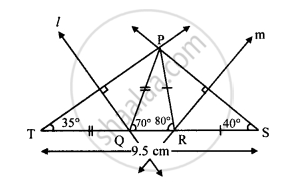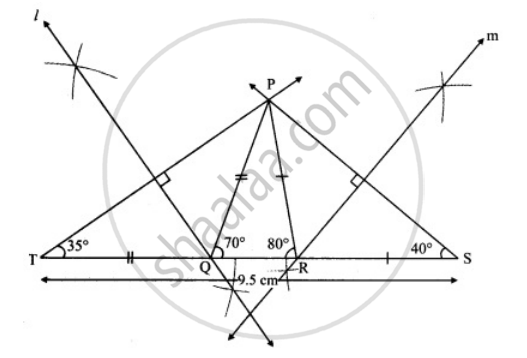Advertisements
Advertisements
Question
Construct ΔPQR, in which ∠Q = 70°, ∠R = 80° and PQ + QR + PR = 9.5 cm.
Solution
Rough figure:

Explanation:
(i) As shown in the figure, take point T and S on line QR, such that
QT = PQ and RS = PR ...(i)
QT + QR + RS = TS ...[T-Q-R, Q-R-S]
∴ PQ + QR + PR = TS ...(ii) [From (i)]
Also,
PQ + QR + PR = 9.5 cm …(iii) [Given]
∴ TS = 9.5 cm
(ii) In ∆PQT
PQ = QT ...[From (i)]
∴ ∠QPT = ∠QTP = x° ...(iv) [Isosceles triangle theorem]
In ∆PQT, ∠PQR is the exterior angle.
∴ ∠QPT + ∠QTP = ∠PQR ...[Remote interior angles theorem]
∴ x + x = 70° ...[From (iv)]
∴ 2x = 70° x = 35°
∴ ∠PTQ = 35°
∴ ∠T = 35°
Similarly, ∠S = 40°
(iii) Now, in ∆PTS
∠T = 35°, ∠S = 40° and TS = 9.5 cm
Hence, ∆PTS can be drawn.
(iv) Since, PQ = TQ,
∴ Point Q lies on perpendicular bisector of seg PT.
Also, RP = RS
∴ Point R lies on perpendicular bisector of seg PS.
Points Q and R can be located by drawing the perpendicular bisector of PT and PS respectively.
∴ ∆PQR can be drawn.
Steps of construction:
- Draw seg TS of length 9.5 cm.
- From point T draw ray making angle of 35°.
- From point S draw ray making angle of 40°.
- Name the point of intersection of two rays as P.
- Draw the perpendicular bisector of seg PT and seg PS intersecting seg TS in Q and R respectively.
- Join PQ and PR.
Therefore, △PQR is the required triangle.

